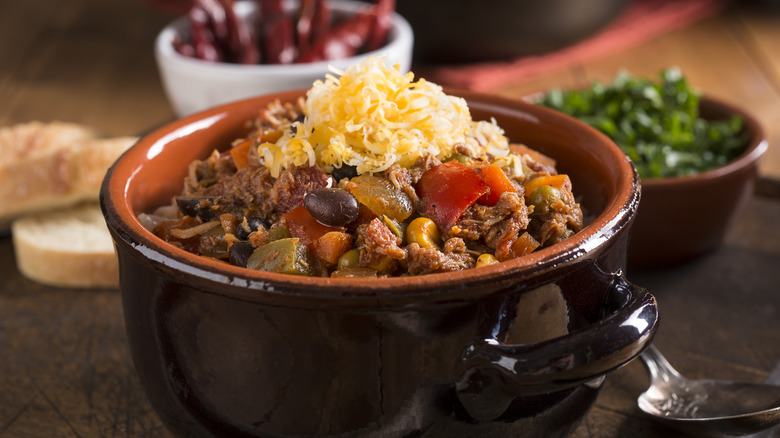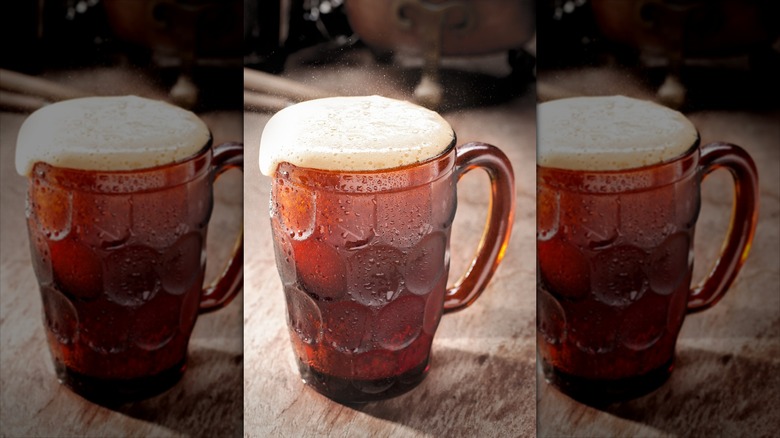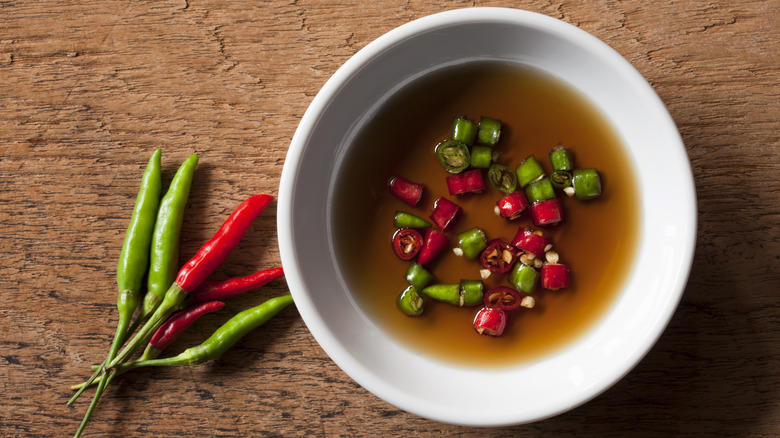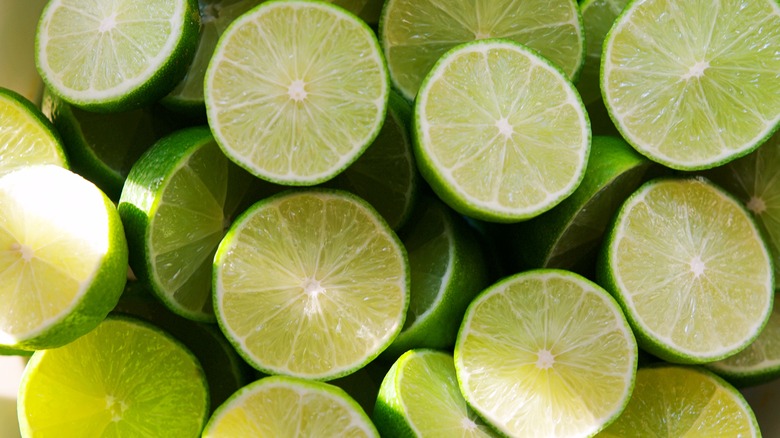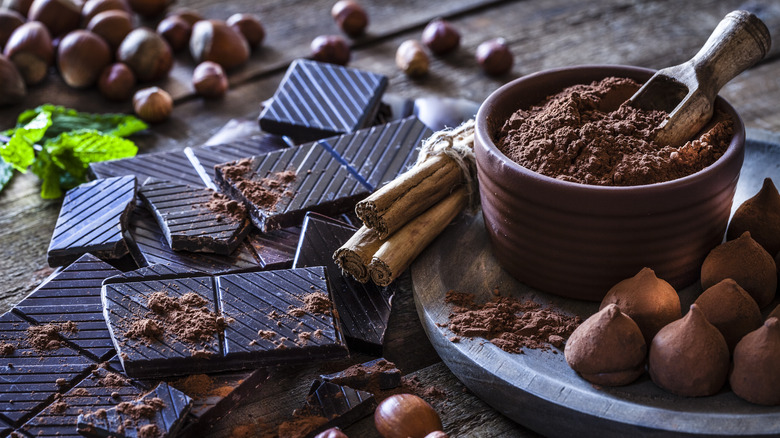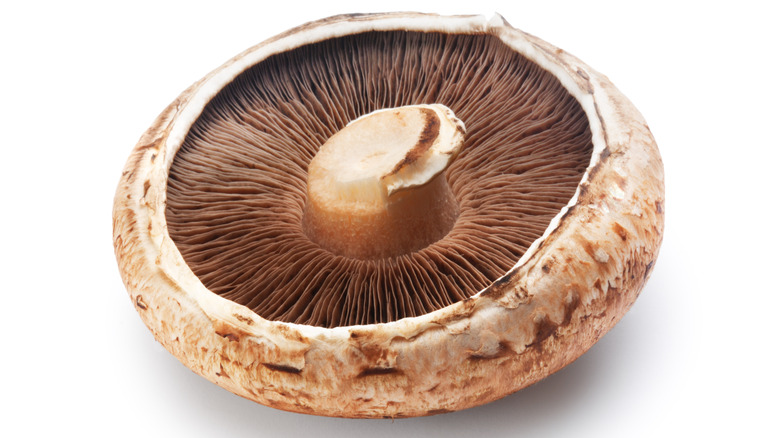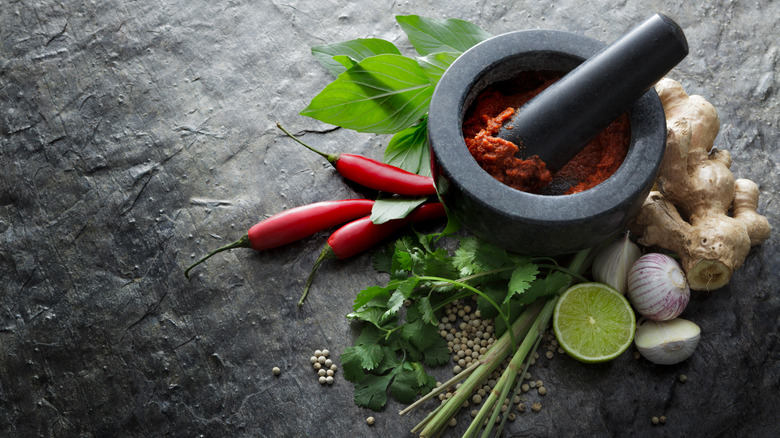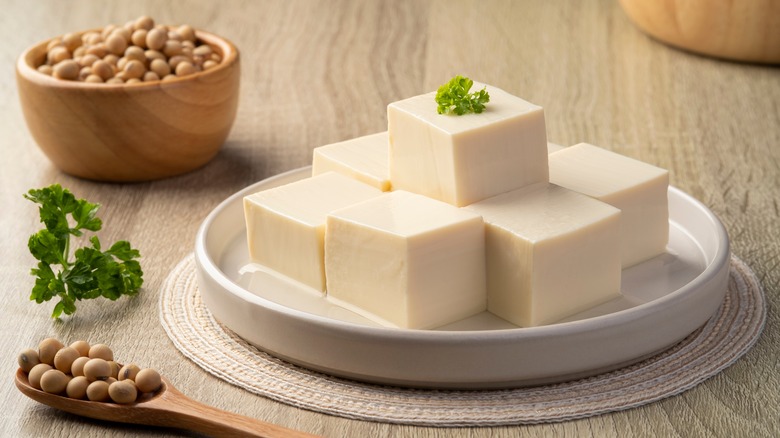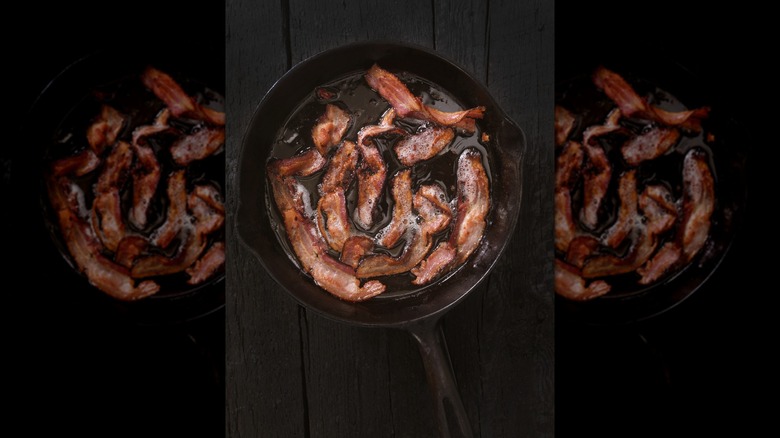14 Off-The-Wall Ingredients You Should Be Adding To Homemade Chili
Stewed chili as a staple meal has as many probable beginnings as any story in the DC Comics multiverse. The ingredients for which are also in dispute, with some being fairly straightforward and others a bit, well, off the wall. Some food historians say it goes all the way back to the 1500s and the Aztecs. That version of chili's history sees Spanish Conquistadors stewed in a chili-like concoction, along with some chili peppers. We know — talk about off-the-wall ingredients. Other versions of chili's history include stories of all of the chili's ingredients being cooked into a fatty brick that was then heated up over an open fire by cowboys until stewed chili emerged. As with most old-time recipes, what went into the recipe rested largely on what was available to the cook and could be preserved without refrigeration.
All of this is to say that if you've ever felt like you couldn't put something in your chili because the ingredient didn't match the recipe for classic chili, we'd like to remind you that chili's history is filled with crazy ingredients. So, your history-making chili can include some off-the-wall ingredients, too. What's more, it'll probably be all the better for it — Spanish Conquistadors as ingredients notwithstanding — because many unusual ingredients heighten the flavor of some recipes, making them taste more like chili than classic chili itself does. So, if you're looking for new ingredients to make your next bowl of chili a standout, here's what we recommend.
1. Maple syrup
If you want to know why maple syrup in chili isn't an abomination, it's kinda necessary to reverse-engineer making chili from scratch. This makes the rationale for maple syrup a bit clearer. Not all chili recipes include tomatoes and meat. However, for the ones that do, tomatoes and meat together serve a practical function. Adding tomatoes to your chili tenderizes the meat because all tomatoes contain acid regardless of how sweet they are. However, because even the sweetest tomatoes contain at least some natural acids, the flavor of those acids will grow stronger because the liquid in the tomatoes evaporates as the chili cooks. This makes tomatoes' acidic nature even stronger. Even though this is true for all the ingredients in the chili – that is, they grow stronger the longer it cooks – adding sugar balances out the tongue's perception of the tomatoes' acid.
However, maple syrup works with the acids in the chili's tomatoes in the same way that sugar does but also adds additional flavors. The overall flavor profile of the chili deepens in a way that doesn't happen with sugar alone. It takes on an almost burnt caramel taste that's just divine.
2. Root beer
When you order chili in Texas, you can expect two things: a bowl of beefy bean-free stew and no tomatoes. Unfortunately, the absence of tomatoes means that you'll need to tenderize the meat another way since you won't have the tomatoes' acids to do it. While some people add ingredients like vinegar in tomatoes' stead, we, being the foodie rebels that we are, insist on going with something a little less pedestrian: root beer.
The soda brings with it some of the same qualities you get from adding cola to a pot roast. It'll be sweet and tender, but the sweetness profile gets more nuances from the root beer than it would from cola. Those who make root beer at home can tell you that it contains myriad flavors like vanilla, sarsaparilla, and sassafras. It hints at licorice, too. But adding soda also means you get citric and phosphoric acids, as well as carbon dioxide, all of which break down the meats' proteins turning the texture into oatmeal. In other words, it has a knock-it-out-of-the-park taste that won't knock your teeth out.
3. Vinegar
When you're building a list of pantry staples, it's unusual to see such a list without at least one type of vinegar on it. If you're a real foodie, you'll have a couple of different kinds: white, apple cider, and red wine. This propensity toward having well-stocked cabinets comes in handy when you decide to whip up some beefy chili and realize you have yet to marinate the meat.
It's such an inexpensive ingredient. Yet, it can save your chili in just a few minutes. Meat marinated in vinegar ensures that it's tender and delicious. Aside from that, adding vinegar to your chili can be the difference between good and great. Often, we'll taste our concoctions and know that they lack something, though we're not sure what. When you make your next batch of chili, and you've hit this culinary wall, add a tablespoon of vinegar to pep up the taste. You'll end up with the umami flavoring that savory dishes like chili are known for.
4. Fish sauce
What if you could, hypothetically speaking, add the taste equivalent of Technicolor to your chili? How would it taste? Would it actually glow like an Oompa Loompa in "Wizard of Oz," burning the taste into your mouth in the same way the world went from black and white to color in that famous film? Would your lips pucker in delight after each dramatic bite?
As it turns out, an ingredient does exist that is pretty much the taste equivalent of Technicolor: fish sauce. Fish sauce, usually made from fermented anchovies that have been squeezed until a stark-smelling brown liquid emerges, often sits on the tables of your favorite Thai restaurant. Its smell is as heightened as you'd expect it to be in the Technicolor world. Plainly, it's very fishy.
But within its fishy scents lie the secret to making your chili taste amazing: glutamate. Glutamate's properties enhance foods' flavors, much like Technicolor enhanced the color experience in 1940s movies. The meat tastes meatier. The beans taste beanier. The peppers taste pepperier! Once cooked, the fishy flavor of the fish sauce disappears, leaving behind a bowl of Technicolor-tasting chili that'll have everyone demanding an encore performance.
5. Lime juice
In dishes like fajitas, lime juice perks up the flavors of the onions and peppers and tenderizes the sizzling meat until it's just the right. The same thing happens when you add this Mexican-food staple to your chili. The lime juice breaks down the meat, making it tender and juicy. Other chili ingredients like red and green peppers and onions also benefit from the lime's acidity because its acids break them down and add a flavor element that makes everything taste better.
When making chili with lime juice, it's perfectly acceptable to cook the lime juice in the chili while all the other ingredients are bubbling and simmering together. The taste of the lime juice will bubble and simmer along with them. However, just as lime juice perks up your fajitas before that first bite, so, too, will it perk up your first bite of chili, so slice up a few limes to serve on the side, too.
6. Dark chocolate
There's a meme that goes around from time to time that perfectly encapsulates the plight of those of us who have a sweet tooth. It goes something like "Life is too short. Eat dessert first." The practical among us don't do this; it's too guilt-inducing. The impractical among us do this during our Freshman year of college. The savvy among us make a compromise and eat them simultaneously, preferably in a form like chocolate-infused chili, which brings together a sweet and savory profile that would make even sweet and sour chicken a bit jealous.
Adding chocolate to chili tastes good for the same reason that adding cayenne pepper to Mexican hot chocolate tastes good. It balances the spiciness of the chili while adding a sweet contrast to the acid of the tomatoes. Dark chocolate is perfect for this. When deciding upon the right kind of chocolate, look for a brand that contains at least 70% cacao. Just add in the dark chocolate once the chili's pretty much done to avoid scorching the chocolate. If you opt for cocoa powder instead, just stir it in when you stir in the other spices. So yum!
7. Portabella mushrooms
For the newly-minted vegetarian or vegan, finding substitutes that replace the flavor and texture of meat in chili is often job number one. While it's true that more vegetarian meat substitutes exist than ever before, they come with some drawbacks. First, they rack up a healthy expense. According to the Good Food Institute, you'll pay twice as much for faux meat as you would for beef, three times as much as you would for pork, and four times what you would for chicken. Second, many of these meat substitutes contain chemicals like iron phosphate and artificial colors. For those who turned to a plant-based lifestyle to support their health, these aren't the best options.
Enter the portabella mushroom. Its savory flavor makes it an ideal replacement for the umami flavor that meats bring to the dish. What's more, the texture of the portabella mushroom mimics the texture of meats like chicken, bringing back some of the textural experiences that chilis filled with meats do. The largest of these mushrooms is the size of a hamburger, though smaller sizes exist. Chop them up to make a vegetarian chili that's as healthy as it is memorable.
8. Red curry paste
Most chili recipes have a spicy nip to them. In fact, spice is nearly everything in a great chili recipe. Here's the thing. Ingredients like jalapeños or cayenne pepper have kinda been overdone in classic chili recipes. So much so that the standard chili recipe runs the risk of being boring; shudder the thought.
Might we suggest something that also has a bit of a spicy nip that would taste great in chili: red curry paste? Those who love Southeast Asian food are familiar with this spicy seasoning blend. It contains within it many of the same ingredients and spices that chili does, like cumin, red chili powder, and coriander. It also brings in hints of ginger and lemon grass. Such a combination offers an out-of-the-box hint at an East-meets-West recipe that doesn't overpower the classic chili taste. And for those who may want an additional flavor boost in this recipe, it's great to cool off the chili's heat by adding a dollop of coconut milk to the top instead of sour cream.
9. Tofu
Tofu takes on whatever flavor it's cooked with, comes in different textures from silken to extra firm, and is an inexpensive source of protein, making it a logical addition to vegetarian chili. The simplest way to add more protein to your chili is to put some silken tofu in the food processor, grind it up, and cook it with the rest of the ingredients. The spices and flavors from vegetables will infuse the tofu with the chili's flavor.
If you feel you need a meatier consistency, you have a couple of options. Drain some firm or extra firm tofu by pressing it between two paper towels and then fry it in the air fryer. You can mimic the effect of having chicken chunks in your chili. The air frying makes the tofu chewy and delicious. Or you can "cheat" a bit by adding soy curls to your chili to replicate chicken or ground beef. Soy curls are a bit like dried tofu that come in a bag. They reconstitute once you add liquid, eventually soaking up the juices from the tomatoes and peppers as the dish simmers. This makes them soft and delicious come dinner time.
10. Beer
If you have any experience as a foodie home chef, you know that you must marinate some types of meats before you toss them into your chili. Think chuck or brisket, which will add hearty chunks of beef to your stewed chili without breaking the bank. As far as marinades go, you have the usual suspects that go into all good marinade recipes. That is, you need something acidic, like vinegar, something spicy, like taco seasonings, or even something as simple as garlic and pepper, and you need some oil. Olive oil works nicely here.
Or you could just open the fridge and pull out a bottle of your favorite brew. The tannins and the alpha acids in the beer turn muscle meat into tender chunks of deliciousness for your chili if you substitute beer for your regular marinade. Beer also contains sugars that cut the acidic taste of the tomatoes. You additionally get a malt flavor kick from the beer. To really amp up the malty taste of the meal, bake some homemade beer bread to go along with your chili.
11. Carrots
During World War II, the British government suggested that those with an insatiable sweet tooth put carrots in their baked goods instead of sugar. WWII sugar rations made baking more challenging, unfortunately. And sugar plays a key role in cake baking. For example, it makes cakes moist instead of chewy like bread. Carrots, being a naturally sweet vegetable, allowed mid-century bakers to keep on baking. If a recipe calls for sugar, you can sometimes substitute carrots. The act of cooking them causes the sugars in the carrots to seep out of the carrots and do the chemistry thing that sugar is supposed to do in a recipe.
Now, let's switch gears to the savorier side of things. There is a reason that carrots end up in pasta sauce, and we would argue, should end up in chili, too. Many chili recipes call for tomatoes, whose natural acids seep into the meat — that's good because acid tenderizes meat – and bad because it makes for a kinda acidy-tasting chili. However, adding some grated carrots to the chili recipe does what sugar would normally do: Balance out the acids in the tomato to create a fuller, smoother taste profile for the chili. But unlike sugar that just tastes like sugar, carrots also have their own flavor profile to bring to the dish, allowing your favorite chili recipe to take on a more nuanced flavor than if you'd used plain ol' table sugar instead.
12. Pumpkin puree
A traditional chili recipe is basically a stew recipe filled with chunks of meat, beans, and depending on the recipe, seasonal vegetables. It's usually thick and hearty and fills an empty tummy on a cold day like few things can. We bring this up because one of the qualities that separates stew from soup is its thickness and lack of liquid, at least compared to the amount of liquid you'd find in your average soup. A few ingredients, like crushed tomatoes or tomato paste, can thicken up your chili. However, not all chili recipes call for tomatoes, leaving you with fewer options for thickening the chili. It also creates a dearth of fiber, something that your body needs to be healthy.
Enter pumpkin puree. It adds some necessary sweetness and earthiness that balances out the flavors in the chili. It's also a way to sneak fiber and other nutrients into your chili recipe but does so in a way that won't overpower the other tastes. Finally, topping your finished chili with pumpkin seeds brings a crunch that's similar to croutons while, at the same time, bringing something original to the recipe.
13. Coffee
A great chili recipe is a good deal akin to creating a scat solo in a jazz piece. The best chilis have an array of flavor notes that not only skitter scat alone across your taste buds but also work together with each different flavor to create a harmonious cohesion within the recipe. Therefore, any ingredient that you add to chili should either balance out all the other flavors or add another separate flavor which makes the dish taste better because of the addition.
If you add plain black coffee to your chili, you'll get such an effect. Coffee has qualities that can make earthy spices like cumin, garlic, coriander, and even hot chilis stand out even more. Think of it this way. Sometimes, you don't notice something until you experience its opposite. Coffee with chili creates the "opposite" the chili's spices need to create a jazzy array of flavors that's unforgettable. Just be careful not to go overboard. Stick to around 8 ounces of coffee to keep the effects of the coffee front and center and the flavor of the coffee itself on the down low.
14. Bacon
If you've ever found yourself jonesing for a bacon chili cheeseburger, then you understand why bacon makes such an excellent addition to your chili recipe. Many of the ingredients in the burger are standard ingredients in chili: the beans, the cheese, the ground beef, and sometimes, some delectable bacon. Whether it's on a burger or in a chili stew, bacon's smokey flavor and, let's face it, its fatty flavor profile interject a taste that lingers on your taste buds.
Historically, cowboys on the range used bacon fat in their chili because the cured meat was always around. Traditional Texas chili started out with bacon frying in a Dutch oven. The other ingredients were then cooked in the drippings. And anyone who has cooked for a long time knows that it's the fat in a dish that binds the flavors together in a recipe. That's often why low-fat foods often have extra sugar or salt in them. Without the fat to trap the flavors, the meal becomes a bit tasteless. Bacon fat, specifically, has a ton of flavor, which is why everything from pancakes to stew that's cooked in bacon fat tastes so good. It's also why you feel full at the end of the meal. Fat in food makes you feel satiated.
But you don't need to stop at just adding bacon fat to your chili. Bacon bits, along with your sour cream, grated cheddar cheese, and green onions, make an amazing topping for your chili, so sprinkle away!
